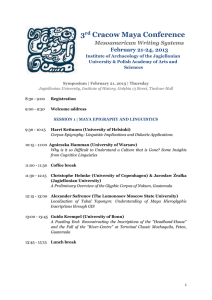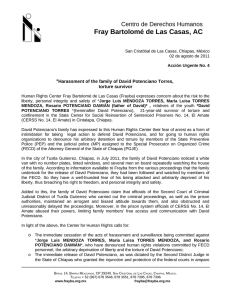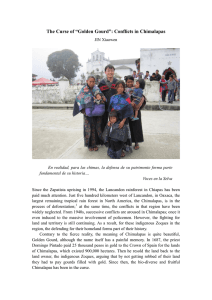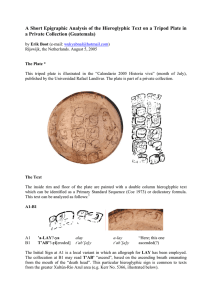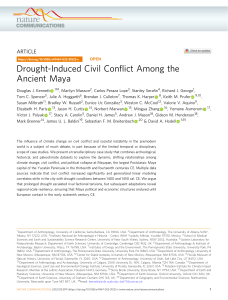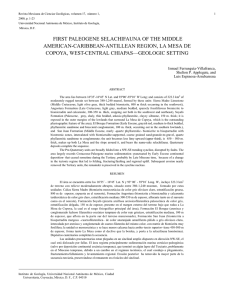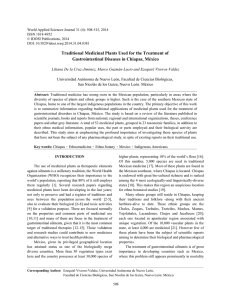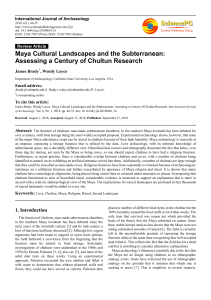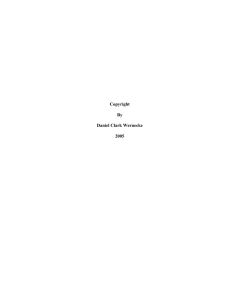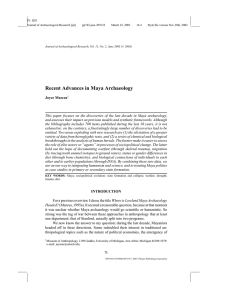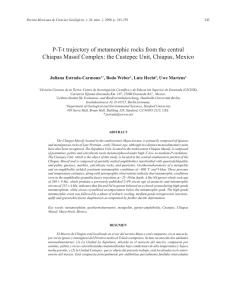An Interview with Robert M. Laughlin
Anuncio
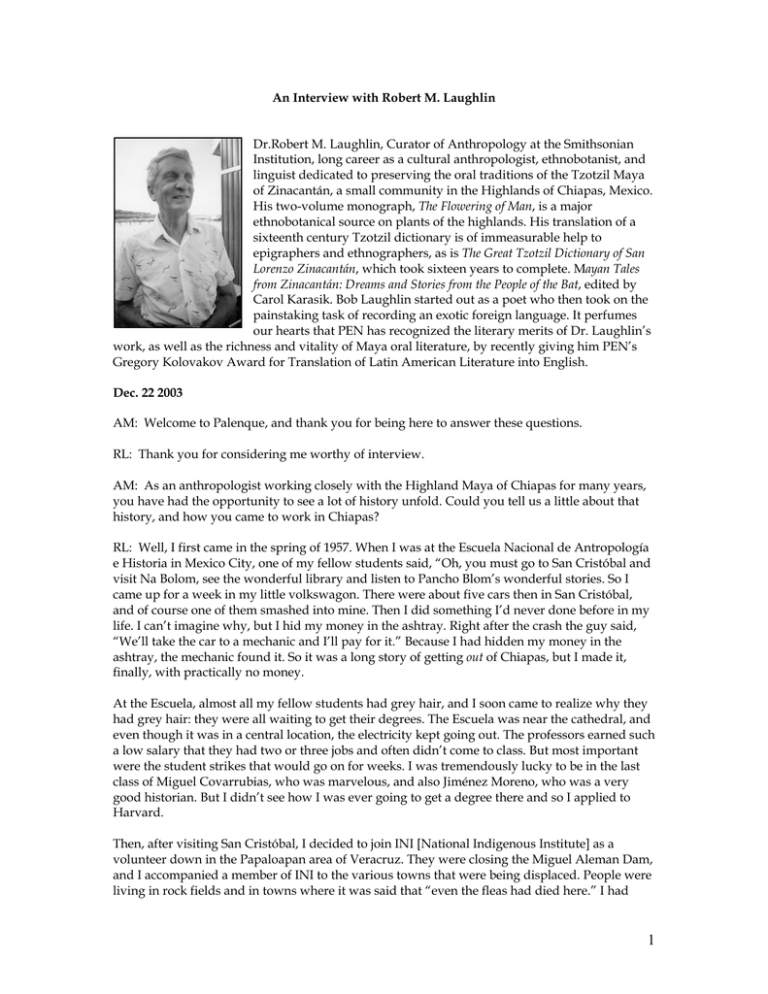
An Interview with Robert M. Laughlin Dr.Robert M. Laughlin, Curator of Anthropology at the Smithsonian Institution, long career as a cultural anthropologist, ethnobotanist, and linguist dedicated to preserving the oral traditions of the Tzotzil Maya of Zinacantán, a small community in the Highlands of Chiapas, Mexico. His two-volume monograph, The Flowering of Man, is a major ethnobotanical source on plants of the highlands. His translation of a sixteenth century Tzotzil dictionary is of immeasurable help to epigraphers and ethnographers, as is The Great Tzotzil Dictionary of San Lorenzo Zinacantán, which took sixteen years to complete. Mayan Tales from Zinacantán: Dreams and Stories from the People of the Bat, edited by Carol Karasik. Bob Laughlin started out as a poet who then took on the painstaking task of recording an exotic foreign language. It perfumes our hearts that PEN has recognized the literary merits of Dr. Laughlin’s work, as well as the richness and vitality of Maya oral literature, by recently giving him PEN’s Gregory Kolovakov Award for Translation of Latin American Literature into English. Dec. 22 2003 AM: Welcome to Palenque, and thank you for being here to answer these questions. RL: Thank you for considering me worthy of interview. AM: As an anthropologist working closely with the Highland Maya of Chiapas for many years, you have had the opportunity to see a lot of history unfold. Could you tell us a little about that history, and how you came to work in Chiapas? RL: Well, I first came in the spring of 1957. When I was at the Escuela Nacional de Antropología e Historia in Mexico City, one of my fellow students said, “Oh, you must go to San Cristóbal and visit Na Bolom, see the wonderful library and listen to Pancho Blom’s wonderful stories. So I came up for a week in my little volkswagon. There were about five cars then in San Cristóbal, and of course one of them smashed into mine. Then I did something I’d never done before in my life. I can’t imagine why, but I hid my money in the ashtray. Right after the crash the guy said, “We’ll take the car to a mechanic and I’ll pay for it.” Because I had hidden my money in the ashtray, the mechanic found it. So it was a long story of getting out of Chiapas, but I made it, finally, with practically no money. At the Escuela, almost all my fellow students had grey hair, and I soon came to realize why they had grey hair: they were all waiting to get their degrees. The Escuela was near the cathedral, and even though it was in a central location, the electricity kept going out. The professors earned such a low salary that they had two or three jobs and often didn’t come to class. But most important were the student strikes that would go on for weeks. I was tremendously lucky to be in the last class of Miguel Covarrubias, who was marvelous, and also Jiménez Moreno, who was a very good historian. But I didn’t see how I was ever going to get a degree there and so I applied to Harvard. Then, after visiting San Cristóbal, I decided to join INI [National Indigenous Institute] as a volunteer down in the Papaloapan area of Veracruz. They were closing the Miguel Aleman Dam, and I accompanied a member of INI to the various towns that were being displaced. People were living in rock fields and in towns where it was said that “even the fleas had died here.” I had 1 never in my life seen such terrible things being done to people. While I was there, I got a telegram from my father saying, “You have been drafted into the army, call me tonight.” The telegram had been sent two weeks before. Finally I called my father and miraculously, during those two weeks, my acceptance had come from Harvard and I was able to get a student deferment. I entered Harvard grad school just at the point when Evon Vogt was starting the Harvard Chiapas Project, studying social change in Zinacantán. He wanted me to study corn, but I wasn’t interested in corn at that time. I wanted to collect myths and folktales, and he said, “Fine, go ahead.” And so I spent a year in Zinacantán doing just that. For my dissertation I compared courtship among the Zinacantecs with the folktales and myths about courtship. After that I collected dreams. Dreams are so important. People wake each other up in the middle of the night to tell a family member a dream, and they remember some dreams for years. I thought I’d publish them, but when I talked to Americans, they said, well, you have to analyze them. I had never had any psychological training in analyzing dreams, so I put them aside and thought, “Here I have this list of vocabulary that I’ve learned collecting the myths and dreams. I’ll just write a dictionary. It will be easy.” That took fourteen years! AM: In retrospect, would you have done it if you had known that it would be such a difficult task? RL: Probably not. But it was an exciting time, because at that point, there was no sure alphabet for Tzotzil Maya. Lore Colby, my predecessor in the Harvard Chiapas Project, helped me work out some of the problems with the alphabet. Then, to collect the words for the dictionary, I used a terribly boring method. Because most of the Mayan roots are monosyllabic, I would test each combination of letters, and as I learned suffixes, add those on and ask, “Is there such a word as that?” We got some pretty funny ones, especially an incredible number of onomatopoeic words for sounds of insects, men pissing, women peeing, horses pissing. I’ve just been reading a book about the J’mong people from Laos and the same is true of the J’mong language before it was written down, similar sounds for trees rustling in the wind, fruit plopping on the ground. This is something that the Spanish language is very poor in. For instance, we never got a good Spanish translation for the sound of a horse clip-clopping down a street. AM: Such a word would have developed later, wouldn’t it? I mean, there wouldn’t have been an equivalent of that in the Classic period. RL: Yes there would; the same verb is used to describe a man walking in ceremonial sandals. Trees were rustling in the wind back in Classic times, fruit was plopping on the ground. That wasn’t the subject of what they were writing on the walls, but people were probably speaking those words. AM: The Great Tzotzil Dictionary of San Lorenzo Zinacantán has been a very valuable resource for epigraphers. When I was studying with Linda Schele at the Maya Meetings in Texas, your dictionary was essential in helping us figure out the meaning of many of the hieroglyphs. Have you had any interest in the ancient Maya writing system, and how does the dictionary and your study of the language compare to what you have read or understand about the epigraphy? R L: You know, I’ve really avoided this subject. I’ve never learned to read the glyphs. I’ve thought, well, I’ll just put out what I can for others to do rather than do it myself. When I was organizing my colonial dictionary, The Great Tzotzil Dictionary of Santo Domingo Zinacantán, I thought it would be helpful to create a thesaurus and group the words by subject, which would make it much easier for people who were working on epigraphy. 2 AM: Surely you must have gotten some interesting feedback from epigraphers. Do they contact you every now and then? RL: Occasionally, but they haven’t done it for years now. Linda Schele was the first to talk to me. I remember one meeting where it seemed like the world was just going to hell. I can’t remember what was going on. My wife and I had dinner with her in Texas, and something just terrible was happening in the world, and Linda said, “I’ve never been happier in my life,” and that was because of her work. At the time everyone was accepting her ideas. But, you know, if you asked a Zinacantec about any one of these ideas, they’d say, “No, that’s not the truth.” That was surprising. AM: Speaking about world events, and particularly those shocking events that affect us all, I know that world events are becoming more and more vivid to contemporary Maya through TV and the Internet. How do you see this more cosmopolitan view affecting the modern Maya and their way of thinking? RL: Well, I remember when the Persian Gulf War was shown on TV and was seen by Zinacantecs. My compadre Anselmo Pérez Pérez was the top shaman in Zinacantán, and he had all the shamans go up to the mountain to pray for protection, because there was no sense of the distance. Where was Iraq compared to Chiapas? Maybe it was just over the hill. Another thing that I remember was when I took Anselmo and Domingo de la Torre to the American Anthropological Association meetings in San Francisco in 1963, and Laura Nader, the social anthropologist, came up to me, weeping, and said, “They’ve just shot Kennedy.” The first time Anselmo and Domingo ever watched TV they saw Jack Ruby shoot Oswald, so it seemed like the United States was a pretty dangerous place to live in. I remember Anselmo saying that the man who shot President Kennedy had never even spoken to him. That was an inconceivable thought. In 1994 when our theatre group, Sna Jtz’ibajom, went to the University of Florida, the word “panMayan” came up. None of our group had ever heard of such a word as pan-Mayan, and wondered what that was. Now they all know what that is! On that trip to Florida, we presented a play in Immokalee. A hundred Chamulas from the Highlands of Chiapas were working there as tomato pickers, and we saw the abuses that these people were subjected to, in a distant way, by the great companies, but more closely by the foremen, who were second-generation Chicanos from Texas. We were there when one of the foremen kicked a worker in the face, because he asked for a drink of water. Workers were told to drink water from “el dich,” polluted water full of pesticides and herbicides. The Coalition of Immokalee Workers had just been founded, and we were supporting the workers. When they called the Department of Agriculture agent in Tallahassee to complain, the workers said, “Now you’ll hear some “theatre” on the phone.” The agent said, “Is he the only one who’s been hurt? We can’t do anything if there is only one person. You have to establish a pattern.” The men in the coalition responded, “How many of us have to be beaten in order to get any redress?” That day we taught the members of the coalition to act out. We created a play together. When we first arrived, everyone in town said, “Oh, the Zapatistas have come!” And as the actors were performing, I saw two or three foremen looking very unhappy. Word had spread that those foremen were going to get our group, and so the coalition workers hurried our actors out at two in the morning to catch their plane in Miami. They had to flee for their lives! Those fellows had armed guards ready to shoot if our group fled. The coalition has just seen to it that five of those Chicano foremen have been jailed for slavery. Yes, slavery! 3 AM: That’s incredible! This brings up an interesting question: within the microcosm of the theatre, how do contemporary Maya playwrights and actors express their views of the world? What has been the evolution of this and where do you think it is going? RL: Andrés Fabregas, who was then a rector of the National University of Chiapas, suggested that we do a play on the Zapatista rebellion. The Zinacantecs in our group said, “No, we are not going to touch this, that’s politics.” Through the centuries the Zinacantecs have always been very prudent; whenever there were rebellions they stood aside, they didn’t want to be involved. A Tenejapan member, Diego Méndez Guzman, was very much for doing a play on the Zapatistas, but the Zinacantecs, said, “No, we’ll do a play on ecology, that’s good.” Around that time the new governor called a meeting with campesinos and Indians, and Diego did a video of it. Afterwards, Bishop Samuel Ruiz and Subcomandante Marcos asked for copies. Diego showed the video to our group and they were amazed to see Indians telling this new Governor what they thought should be done for them. And so the Zinacantecs finally said, “Okay, but let’s do a mix, ecology and the political side of the Zapatista rebellion.” So that’s what they did, and it fit perfectly. The play shows how the Ladino landowner sees to it that the Indians lose their land and are sent down to the jungle. They cut down the jungle, the animals complain to the Earth Lord, the Indians get sick as a punishment from the Earth Lord, and then a young student comes from the capital and says, “We must organize!” There’s a battle, and then the Earth Lord comes out and says, “You are brothers, you must not fight each other, there must be peace,” and the Indians rise up from the ground and say, “Yes, peace but with justice.” And then they sing the Chiapas anthem. This play has been very popular all around Chiapas. When they showed it in Florida, an African student said, “If this were shown in my country, we’d be killed.” But we’ve never had any problem from the Chiapas government or the federal government, and I think very likely because of the emphasis on ecology. A few years ago they performed the play in a remote settlement near El Ocote Biosphere Reserve. Earlier, Sna Jtz’ibajom had done a video on animal protection, and somehow that video had gotten to that community. They had to travel there by boat, and when they arrived, one of the people standing on the shore looked at Juan de la Torre, and said, “I know you,” because he had seen him on the video. They gave the play in the late afternoon and then went off to take a nap when all of a sudden one of the people in the community came to them and said, “You can’t go to sleep, the teacher says we must have a meeting.” So they had a meeting and decided, “Look, we can’t let what’s happened to those people in the play happen to us. We each have ten hectares of rainforest. We must see to it that those trees are not cut down.” The people described how they had been pushed up the mountain slopes because of the dam and were still lighting their fires with pine while the wealthy were sitting in Mexico City watching TV with the electricity that the dam generated. About half of the plays that Sna Jtz’ibajom presents are social action plays, or at least about social, economic, or political problems, and about half are based on myths, which are used to strengthen traditional ideas. One of the plays we are reviving is called “Jaguar Dynasty.” It’s a play about King Shield Jaguar and Lady Shark of Yaxchilán. It was very popular when it was first done. People got very excited, because it was the first time contemporary Mayas had ever seen these famous historical figures on stage. That play shows how Lady Shark is rebuffed by her husband, and her son is not chosen to be the successor. Another theatre group, FOMMA [Fortaleza de las Mujeres Maya], portrays the current situation of women, a thousand years later, trying to gain some political equality. 4 AM: Within Maya communities there is a very theatrical aspect to the religious pageantry and processions. Do you think that Sna Jtz’ibajom will have an influence on the ritual life of their communities? Or is theatre viewed in the western way as entertainment? RL: It’s thought to be more than entertainment. Our guys have said that every play has a reason, and they make very clear to the public what the reason is. There is no question that the productions are considered to be tools for teaching. I think the religious ceremonies are too rigid to permit the introduction of new ideas, but maybe not. AM: I guess I’m thinking about the traumatic events that have been incorporated into religious ceremony. One, for instance, is the expression of the Conquest, which has found its way into fiestas in Chamula and Zinacantán. Also there is the representation of the Montezumas. Do you think perhaps the Zapatista rebellion will surface somewhere? RL: Now there is one thing that did happen. We have a play on the j’ik’al, the “spook,” and the spook wore a black cloak. After we presented the play, several Zinacantecs asked us to design or to give them the black cloaks to wear for Carnival. At Carnival in Zinacantán, the people who impersonated spooks usually dressed as Ladinos. But they were so fascinated with the cloak and the black devilish mask that some people have adopted the cloak and mask as part of the costume. AM: Just recently you spoke to me about Classic Maya urban centers as “theatrical kingdoms.” Could you describe this concept and how it relates to contemporary Maya religious pageantry? RL: Well, I believe this term was coined by Arthur Demarest, who thought that all the pageantry that was going on was a vital part of legitimizing the rulership, and, I’m sure, a form of propaganda. The kind of ritual that goes on now is not so political. You don’t have religion and politics quite so intertwined. Civil politics is separate really, and is becoming more and more separate. AM: I know you have taken trips with contemporary Maya from the Highlands to Classic Maya sites. Have you gained any insights from their observations during those visits? RL: Oh, I have a funny one. It was in Copán and Linda Schele was there. We were looking at the stelae and she was going on in her broken Spanish about what was being shown on them, and finally my compadre Anselmo, a shaman, just walked away. I think it was her manner more than what she was saying. But then a curious thing happened. After we came back, we were thinking of a manual for our literacy course, and I saw Anselmo writing out numbers in Tzotzil, from one to two hundred, which nobody knows. They made that a part of our manual, so they thought it was that important. Everybody wanted to keep it. It was like a philosophical game, even though nobody would use it in speaking. AM: And what do the Zinacantecs see when they look at the stelae of kings? Do they ever comment to you about who these people were? RL: Well I’ll tell you, when I brought my compadre Domingo de la Torre here to Palenque, he was totally bored. Then he saw one of those dark entrances in the Palace. For contemporary Maya, as for the Classic Maya, caves are tremendously important. All we had were matches, and we crept in a little bit, but suddenly things clicked. Suddenly this was interesting. Then he saw carved on a wall a ceremonial sandal that looked just like Zinacantec ceremonial sandals, and he uttered, “Who were these people?” Did they come before the flood?” And then he said, “These stones weren’t cut with metal.” Isn’t that just amazing? I don’t know how he would know that. As we 5 walked back down the trails he said, “Where are all the souls, all the spirits, gone?” And when we sat up on the Temple of the Inscriptions and watched the sun set, he turned to me and said, “You know, your comadre and I really ought to move here because I’m sure there is strong power here and we’d be strong shamans here.” AM: Those are beautiful images. Now I’d like to ask about your book on ethnobotany, The Flowering of Man: A Tzotzil Botany of Zinacantán. What was the driving force behind your study of plants? RL: You know, I just discovered a curious thing when I was rereading my fieldnotes. There I was, sitting in Zinacantán, unable to speak a word of Tzotzil, and the first questions that I asked were the names of plants. The easiest thing to do was to point to a plant and say, “How do you say this in Tzotzil?” I had quite a long list of plant names in my first vocabulary. Later, when I was starting the dictionary, Dennis Breedlove, the botanist, said, “You can’t do a dictionary without plant names. I will help you.” And so we started the whole business of collecting plants. AM: So basically you got a crash course in ethnobotany. RL: Absolutely! I knew nothing. One of the hardest things, the most perplexing of all, was corn. When we hung up twenty-five ears of corn and had people come in and name them, we got something like seventy-five names. We had no idea what was going on. But when I was in the States, I had fun asking Americans about car types. I would show them pictures of cars and ask what car it was and everyone said that a Chevy was a Ford. The same for cereals and vegetables. Professors at Cornell couldn’t identify spinach, because they’d always sent their wives to the store. Anyway, we were left with some serious questions about the plant names we had put in the dictionary, particularly, as I said, with corn. Then we thought, “Let’s revise our work, let’s do an ethnobotany with the material we have in the dictionary. It won’t take long.” Ten years! But I might add one thing. I don’t know if it’s true, but I was told that this is the most comprehensive ethnobotany of any indigenous community in the world. AM: You’ve recently completed a beautiful illustrated book, Mayan Hearts, which contains Maya metaphors for love, fear, passion. RL: Actually my latest book is La gran serpiente cornuda: Indios de Chiapa no escuchen a Napoleón [Beware the Great Horned Serpent: Chiapas Under the Threat of Napoleon], about a Spanish proclamation sent to the colonists in 1812, promising them new roads, schools, etc., so long as they didn’t listen to “the murderer Napoleon.” AM: What is your next project, aside from continuing work with the theatre? RL: I have to write an introduction to “Travelers to the Other World.” Carol Karasik made a selection from the journals of my compadres on their trips to the States in 1963 and 1967, which is the first description by Mayas of the US. Carter Wilson, the novelist, suggested that the book begin with Mimi’s and my arrival here in this “other world,” which was so different from ours. It was a tremendously hard year for my wife. She really resented the patriarchal Maya culture. For me it was an adventure to put on their clothing, for her it was an attack on her identity. As a man I could go out and visit and do things and she was supposed to stay at home, which was no fun. And one thing I was astonished to read in my fieldnotes was that there was hardly a day that ended without me being drunk. I mean it was just extraordinary. And though I was never violent, she had to cope with a pretty boring husband who goes to sleep every time he comes home. 6 When I came to Chiapas, I thought I’d like to have a Tzotzil name, and since there were no Roberto’s in Zinacantán, I adopted the name of the patron saint, Lorenzo, and so I’m Lol. I translated my surname, Laughlin, “little lake,” to Bik’it Nab, which is Tzotzil for Little Lake. There is a community called Bik’it Nab that belonged to Zinacantán in the 18th century. I thought it would be fun to trace my roots and go to Bik’it Nab. It would be fun to tell people I’m Lol Bik’it Nab. I’d like to collect some of their creation myths and see how similar they are to those from Zinacantán.* AM: In studying these creation myths, do you also compare them to ancient versions of the creation story? RL: Well I haven’t yet, but that would be something that I could do. There might be some exciting surprises, who knows? AM: We look forward to seeing these new books and thank you very much for sharing with us. RL: You’re very welcome, I hope I live to do them. * After giving this interview I learned that Laughlin (Lachlann) does not mean Little Lake, but Norseman or Viking! I also learned that no one born in Bik’it Nab is alive today. 7
